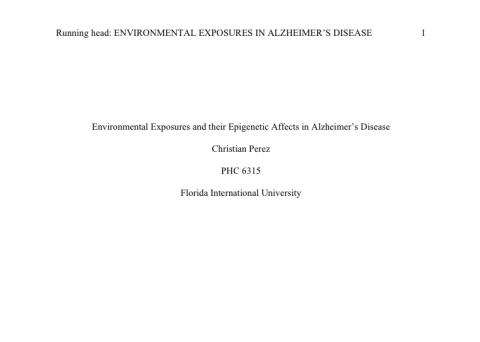Alzheimer's Disease Graduate Research Article
Jul 16,2016
https://portfolium.com/entry/alzheimers-graduate-research-paper
<div class="portfolium-entry-widget" data-id="252491" data-width="300"></div>
<script src="https://portfolium.com/assets/js/portfolium.js" async></script>
Environmental Exposures and their Epigenetic Affects in Alzheimer’s Disease
Christian Perez
PHC 6315
Florida International University
Abstract
Modern medicine has used technological advancement and progresses in research to provide effective treatment against the plethora of diseases humans can incur. Strides in research have aided in reducing non-communicable (noninfectious) disease fatality rates. According to recent census analysis by Hebert, Weuve, Scherr, and Evans (2013) reductions of heart disease and cancer fatality rates were diminishing in the United States. However, Alzheimer’s Disease remains an enigma with its few treatment options it is steadily increasing in the global population. Environmental exposures have only recently been studied with some detail as possible protagonists for Alzheimer’s onset. This paper explains how chemical, biological, genetic, and sociological factors a person exposes themselves to in their environment increases risk of Alzheimer’s Disease onset.
Introduction
Alzheimer’s Disease is a severe form of dementia that normally displays its initial symptoms of moderate memory loss around 60 years of age; consequently, its symptoms worsen at different rapid rates over time depending on the individual as the parts of their brain responsible for memory, emotions, and motor control fail to operate (Hebert et al., 2013). The prevalence of Alzheimer’s in the United States is a major public health crisis that requires more research in order to develop effective treatments. Projections show that 61 million Americans known as Baby Boomers born between the years of 1945 to 1964 during the period of substantial increase in births following the end of World War II will all be at or above 66 years of age by the year 2030 (Knickman & Snell, 2002). According to the Center of Disease Control and Prevention (2014) a staggering 13.8 million people will have Alzheimer’s by the year 2050 at current onset rates; meanwhile, the cost of care for these individuals will rise to a staggering $ 500 billion dollars placing a burden on the economy. According to data compiled by the Alzheimer’s Association (2015), Alzheimer’s affects women much more than men since they possess higher amounts of risk factors like higher β-amyloid protein levels, higher cognition, and longer life spans as compared to men. Furthermore, mental deterioration occurs twice as fast in women versus men and about 60% of Americans with Alzheimer’s are women (Fig. 1). This data further stresses the necessity of better treatment options that must be specialized according to the gender factors associated with the individual a unique trait unlike other diseases.
Fig. 1: Gender and Alzheimer’s disease data, source: (AA, 2015)
Alzheimer’s disease is classified into three causative factor group’s chromosomal (<1%), familial inheritance (25%), and the unknown environmental/genetic interactions which result in Alzheimer’s (75%) through epigenetic abnormalities (Table 1). Each case of the disease tends to show the presence two distinct molecular abnormalities stemming from genetic or environmental origins; furthermore, these structures hinder effective communication across neuronal pathways of the brain. One of these anomalies is β-amyloid plaque formation where β-amyloid protein commonly present throughout the brain accumulates into mass over the years that act like roadblocks slowing or completely impeding neuron communication. The second abnormal molecular formation are neurofibrillary tangles, which are helical fragments of tau protein which abnormally phosphorylate resulting in tangled intraneuronal webs which inhibit proper neuron signaling reliant upon the conductive nature of myelin protein that surrounds the axons in neuron cells. This paper will touch upon each of the causes of Alzheimer’s, but it will primarily focus on environmental exposure research that is lacking now and may help prevent 75% of Alzheimer’s caused by epigenetic changes from the environment. It is becoming more apparent that social, biological, chemical, and genetic changes occur from environmental hazards, which lead to an array of health problems. The purpose of this paper is to explain how complex environmental risk exposures entail oxidative stress, neurotoxic elements, high cholesterol diets, genetic mutations and biological viruses that play an essential role in Alzheimer’s in order to display possible preventions that can be undertaken to reduce prevalence of the disease in the future.
Table 1.
Causes of Alzheimer Disease
Cause
% of Cases
Chromosomal (Down syndrome)
<1%
All familial
~25%
- Late-onset familial (AD2)
15%-25%
- Early-onset familial AD (AD1, AD3, AD4)
<2%
Unknown (includes genetic/environment interactions)
~75%
Source: (Bird, 2015)
Genetic Markers of Alzheimer’s
The genetic markers for Alzheimer’s disease are dependent upon whether it was early-onset or late-onset as well as there is a history of familial inheritance. Early-onset Alzheimer’s disease (EOAD) is identified by mutation of the PSEN1 gene used as a marker in genetic screenings for patients who had the disease prior to 60 years of age; meanwhile, the APOE gene is used as the genetic marker for late-onset Alzheimer’s disease (LOAD) patients who acquired it after 60 years of age (Bird, 2015). The PSEN1 gene is the site of 3 locus mutations (AD3, AD1, AD4) that leave individuals predisposed to getting EOAD by abnormal Presenilin and amyloid protein plaque formation (Bird, 2015). The APOE genotype has proven to be a consistent marker for LOAD for most cases with variation of onset rates dependent upon the two alleles one inherits at the gene. The e3/e4 allele combination leads to abnormal overexpression of amyloid protein and the highest predisposition of developing Alzheimer’s disease. The genetic risks that result from the PSEN1 and APOE play a role in having even more of a negative response to neurodegenerative environmental exposures.
Environmental Results of High Cholesterol Diet and Lack of Exercise
Apoliprotein E is expressed by the APOE gene and interacts with cholesterol phospholipids located in the membranes of neuronal cells interfering with proper communication of the cells. The first environmental exposure of this article is the ingestion of high cholesterol diets that have been correlated with Alzheimer’s. In a study investigating apoliprotein E and cholesterol in diets of 74 elderly individuals, participants shown to have had higher levels of LDL (low-density cholesterol) from dietary intake of food high in saturated fats and a lack of routine exercise daily developed much higher amounts on a PET scan of amyloid protein plaque formation that had components of apoliprotein E as well (Reed, 2014). In figure 2, it is shown how the neural cells known as astrocytes responsible for support and cleaning up of debris in the CNS actually deposits apoliprotein E onto cell receptors of neurons resulting in inhibited CNS signaling. Thus, healthy dieting and regular exercise to increase blood perfusion to the brain are recommended preventions to the development of Alzheimer’s.
Fig. 2, Apoliprotein E and High Cholesterol Affects
Source: (Vance, 2012)
Neurotoxic Chemicals and Metals Deleterious Effects
Neurotoxic elements constitute something by nature that produces damage and makes undesirable epigenetic changes to a person’s normal neural system functioning. Many neurotoxic elements have been exposed to individuals with Alzheimer’s mostly due to their unawareness of them being dangerous or present. Neurotoxicity of metals which may have been present in tap water, wiring, and very recently in gasoline could have had adverse affects to the neuronal system of Alzheimer’s patients in the population. A study investigating aluminum, zinc, and copper environmental interaction with the hippocampus neurons showed that long term exposure to these metals increased the amount of neurofibrillary tangles a trademark of Alzheimer’s onset (Walton, 2009). Lead is also a highly neurotoxic metal known to cause dysfunctions of cognition, development of neurons, and plasticity of memory recall all deleterious risk factors for having serious dementia with age. Many more metals in our environment have a degree of neurotoxicity making it imperative to provide awareness to limit exposure to them in the general public. Neurotoxic chemicals such as organophosphates and organochlorines are also a major risk factor for mental disorders and could be avoided with proper preventative methods. The aforementioned chemicals are a major occupational hazard in workers who use pesticides or people exposed to these pesticides. A study investigating pesticide interaction in 3024 elderly individuals of Cache county showed that the 524 individuals who reported any exposure to these pesticides developed dementia; furthermore, the individuals whose occupation involved regular work with these pesticides all developed Alzheimer’s disease (Carbone et al., 2010). Reduction and prevention of organophosphate and organochlorine use should be more stressed.
Environmental Pollutants and Sleep Inducing Drugs Promoting Risk of AD
Chemical messengers known as neurotransmitters help communication of higher mental processes. Drugs which inhibit the neurotransmitter acetylcholine a key neuronal messenger promote slowing down of key memory recall processes that reduce Alzheimer’s risk. Many elderly individuals suffer from insomnia and are unaware of the anti-cholinergic mechanisms of the drugs they are taking. A study at the University of Washington School of Pharmacy linked 3,000 participants showed an alarming 63% increase in development of Alzheimer’s after taking anti-cholinergic drugs to sleep like Nytol and Benadryl when compared to elder’s not prescribed the same medicine showing the responsibility that needs to be undertaken by physicians when prescribing to the elder’s mental inhibitory medication (Breitner et al., 2009). Possible alternatives could be considered and our available according to the researchers involved in the last survey but simply individuals are exposed to these affects unwittingly. Environmental pollutants such as dioxins, polychlorinated biphenyls, and chlourocarbons have shown deleterious effects to higher mental processing. Table 2 below shows how a dioxin called tetrachlorodibenzo-p-dioxin a byproduct of large chemical manufacturing cause higher rates of phosphorylation in the tau protein of neuroblastoma culture cells which is highly important to note since that protein is involved in neurofibrillary tangle formation resulting from epigenetic changes. Also, particulates that are a major source of air pollution cause cardiovascular and pulmonary issues that limit supply of oxygen rich blood to the brain slowing cognitive processes.
Oxidative Stress Exposure and Alzheimer’s
Factors that cause stress of person’s mental processed and lack of quality sleep that reduces flushes out dangerous toxins of the brain are major risk factors for Alzheimer’s. A state of constant stress overexerts the mitochondria of neuronal DNA and results in reactive oxygen species (ROS) known as free radicals. Free radicals cause major dysfunction in cellular machinery and structuring because they are left alone after oxidative phosphorylation so they bind to nearby neurons. ROS if accumulated at very high amounts over time damages via oxidation CNS support cells such as microglia and astrocyte thus the body loses its natural antioxidant defenses overtime leading to a much higher risk of collapse of mental functioning as seen in Alzheimer’s. Oxidative stress also increases the action of Bace1 an enzyme that cleaves amyloid precursor proteins to an abnormally high level thus increasing amyloid plaque formation this process is shown in figure 3 below. Also, stress can create a weakened immune system more prone to viral diseases such as meningitis that can hijack neuronal cell DNA to use it for its own purposes. Social factors promoting stressful lifestyles of a person’s occupation and lack of proper sleep patterns should be limited throughout one’s life to promote proper neuronal system functioning.
Fig. 3 Oxidative Stress and Amyloid Plaque Formation Steps (Source: Zuo et al., 2014)
Conclusion
The purpose of this study was to see if environmental factors played a crucial role is Alzheimer’s disease development and if so how can public health professional increase risk awareness of exposures to an aging population. Familial inheritance of Alzheimer’s Disease can be tested by genetic screening using PSEN1 and APOE as genetic markers that can tell if an individual is more prone to damage from bad environmental exposure. Constant exposure to an environment where neurotoxic elements like lead and pesticides, high cholesterol dietary options of fast food, stressful occupations, and environmental pollutants like dioxins could have all played a role in the complexity of Alzheimer’s development. The first improvement must be done by healthcare officials in power who can take use a health policy of restricting neurotoxic chemicals, metals, and agents from older individuals. Another factor to be considered is the gender gap associated with the disease and how hormonal imbalance of estrogen in women may be related to Alzheimer’s disease mechanisms of development. of The aging population in the United States need to be better educated on all factors that promote Alzheimer’s development and not be of the belief that higher cognition or no familial history of the disease makes one impervious to having it. A risk assessment profile of a person’s exposure to environmental hazards over a lifetime can be a cost effective tool that is not properly utilized. The future of Alzheimer’s disease is dependent promising drug therapies that are targeting enzyme activation beta and gamma secretase which cleave amyloid protein from cell membranes; furthermore, researchers are targeting tau protein conformational changes that cause the neurofibrillary tangles mentioned earlier. Only through better treatment options and higher awareness of the risks an environment can possess could the damage to higher cognitive processes be reduced as well as the rate of Alzheimer’s fatalities.
References
Alzheimer’s Association (2015). What is Alzheimers? Retrieved from
http://www.alz.org/alzheimers_disease_what_is_alzheimers.asp
Bird, T. D. (2008). Genetic aspects of Alzheimer disease. Genetics in Medicine, 10(4), 231-239.
Breitner, J. C. S., Haneuse, S. J. P. A., Walker, R., Dublin, S., Crane, P. K., Gray, S. L., &
Larson, E. B. (2009). Risk of dementia and AD with prior exposure to NSAIDs in an elderly community-based cohort. Neurology, 72(22), 1899-1905.
Carbone, I., Lazzarotto, T., Ianni, M., Porcellini, E., Forti, P., Masliah, E., ... & Licastro, F.
(2014). Herpes virus in Alzheimer's disease: relation to progression of the disease. Neurobiology of aging, 35(1), 122-129.
Center for Disease Control & Prevention (2015). Alzheimers Disease. Retrieved from
http://www.cdc.gov/aging/aginginfo/alzheimers.html
Genetic Home Reference (2015). APOE. Retrieved November 7, 2015 from
http://ghr.nlm.nih.gov/gene/APOE.
Hayden, K. M., Norton, M. C., Darcey, D., Østbye, T., Zandi, P. P., Breitner, J. C. S., &
Welsh-Bohmer, K. A. (2010). Occupational exposure to pesticides increases the risk of incident AD The Cache County Study. Neurology, 74(19), 1524-1530.
Hebert, L. E., Weuve, J., Scherr, P. A., & Evans, D. A. (2013). Alzheimer Disease in the
United States (2010–2050) estimated using the 2010 census. Neurology, 80(19), 1778- 1783.
Knickman, J. R., & Snell, E. K. (2002). The 2030 problem: Caring for Aging Baby
Boomers. Health services research, 37(4), 849-884.
Manivannan, Y., Manivannan, B., Beach, T. G., & Halden, R. U. (2015). Role of Environmental
Contaminants in the Etiology of Alzheimer's Disease: A Review.Current Alzheimer Research, 12(2), 116.
National Center of Biotechnology Informantion (2015).
Reed, B., Villeneuve, S., Mack, W., DeCarli, C., Chui, H. C., & Jagust, W. (2014).
Associations between serum cholesterol levels and cerebral amyloidosis. JAMA neurology, 71(2), 195-200.
Sul, D., Kim, H. S., Cho, E. K., Lee, M., Kim, H. S., Jung, W. W., ... & Park, S. Y.
(2009). 2, 3, 7, 8-TCDD neurotoxicity in neuroblastoma cells is caused by increased oxidative stress, intracellular calcium levels, and tau phosphorylation.Toxicology, 255(1), 65-71.
Vance, J. E. (2012). Dysregulation of cholesterol balance in the brain: contribution to
neurodegenerative diseases. Disease models & mechanisms,5(6), 746-755.
Walton, J. R. (2009). Evidence for participation of aluminum in neurofibrillary tangle formation
and growth in Alzheimer's disease. Journal of Alzheimer's disease: JAD, 22(1), 65-72.
Zuo, L., Hemmelgarn, B. T., Chuang, C. C., & Best, T. M. (2014). The Role of Oxidative
Stress-Induced Epigenetic Alterations in Amyloid-β Production in Alzheimer’s Disease. Oxidative Medicine and Cellular Longevity. 22(1), 65-72.





